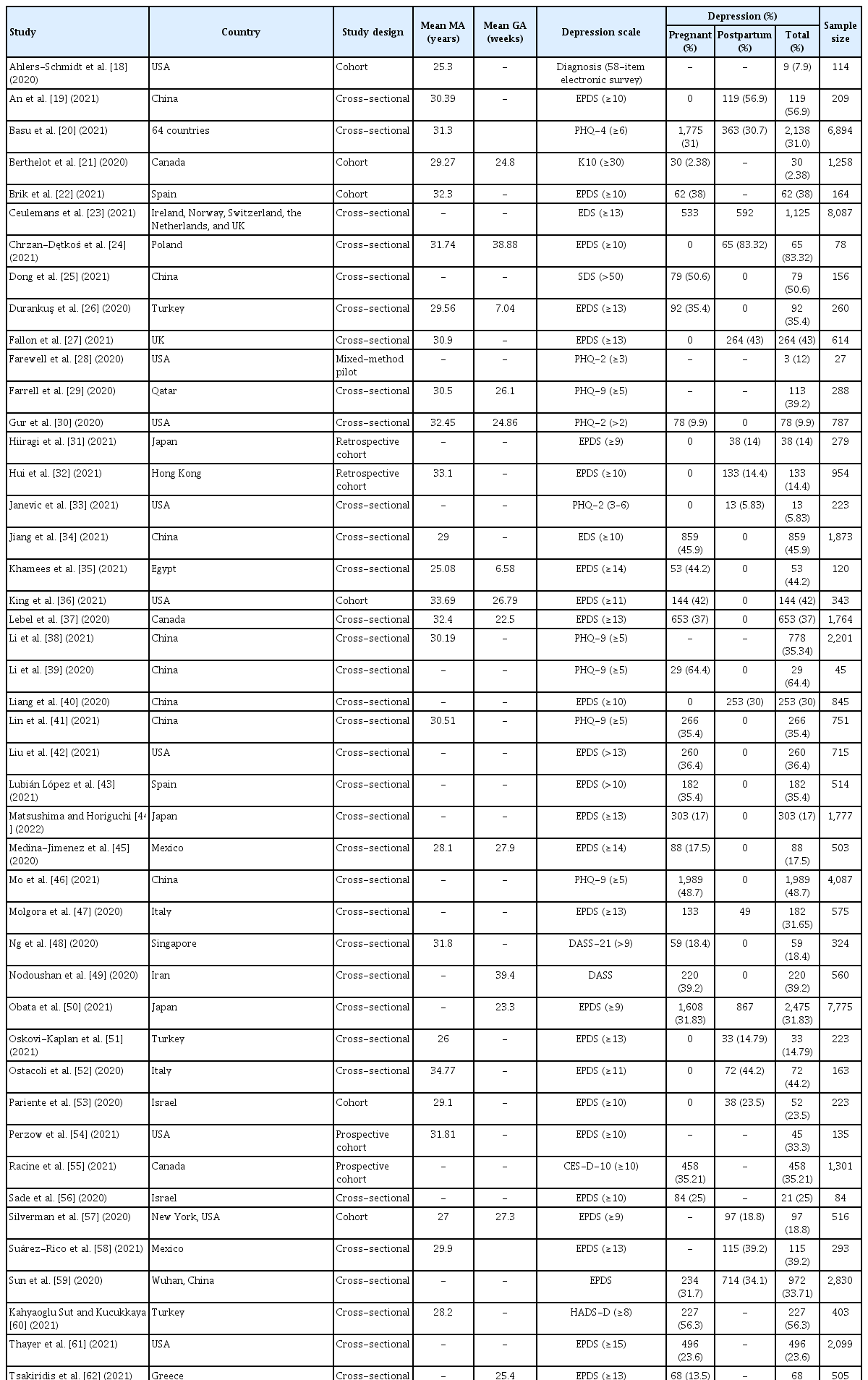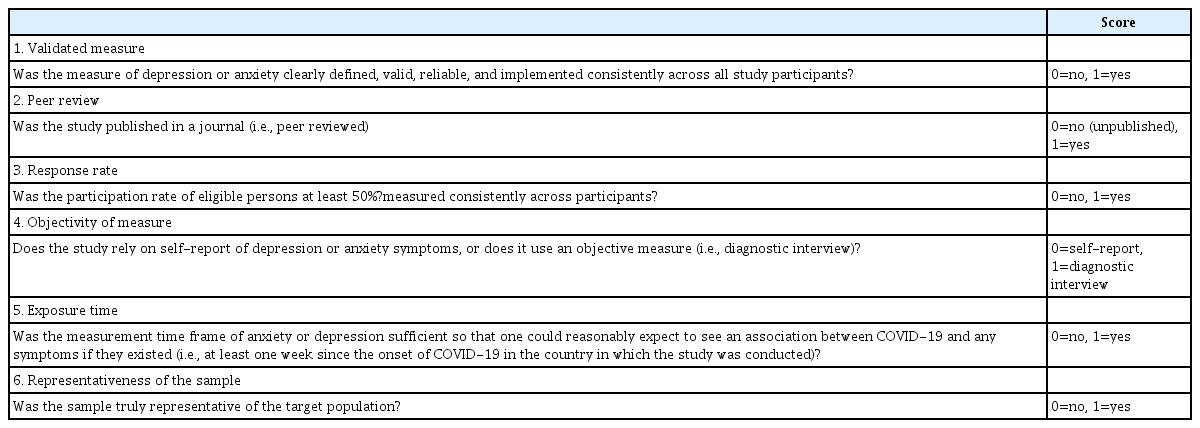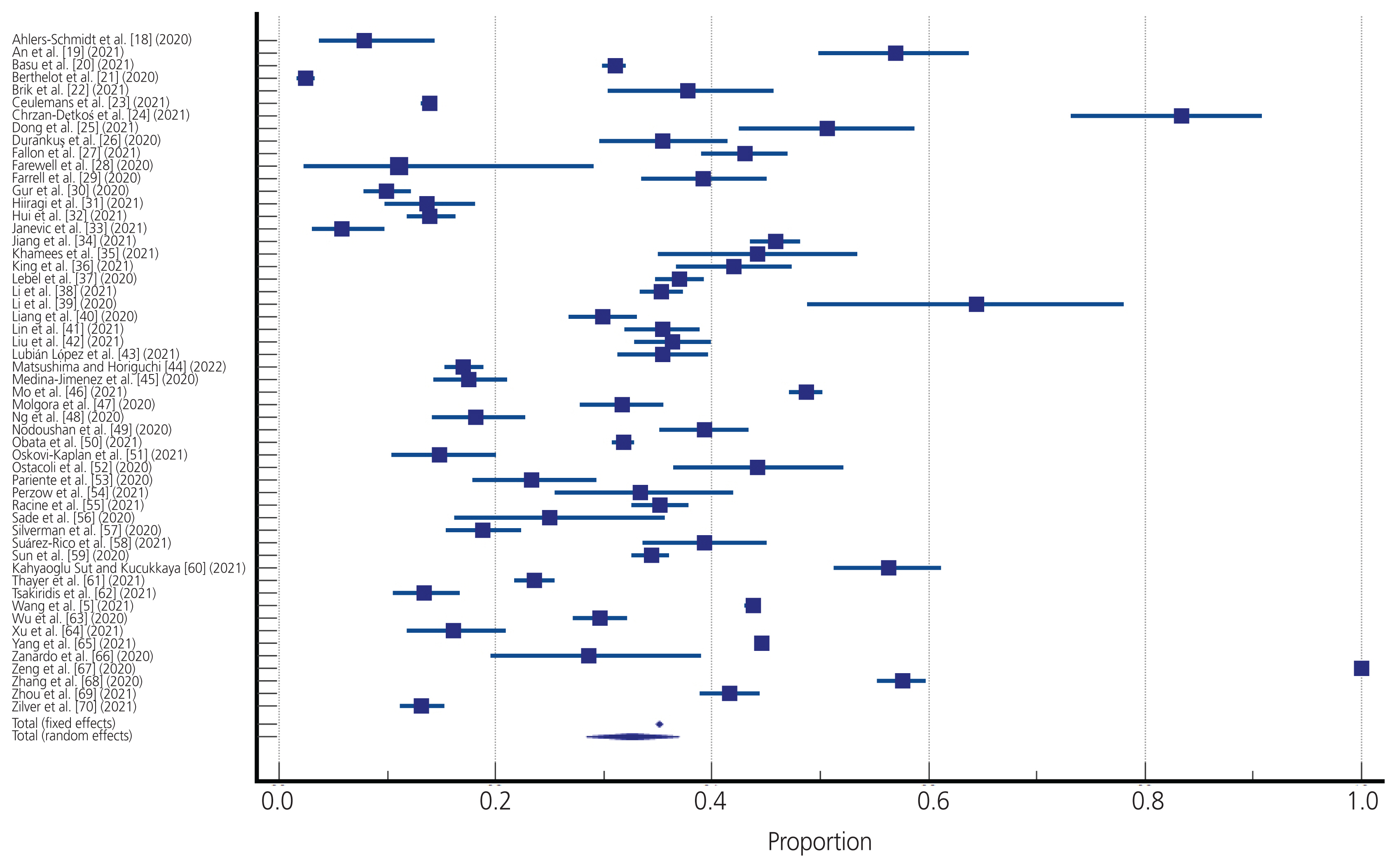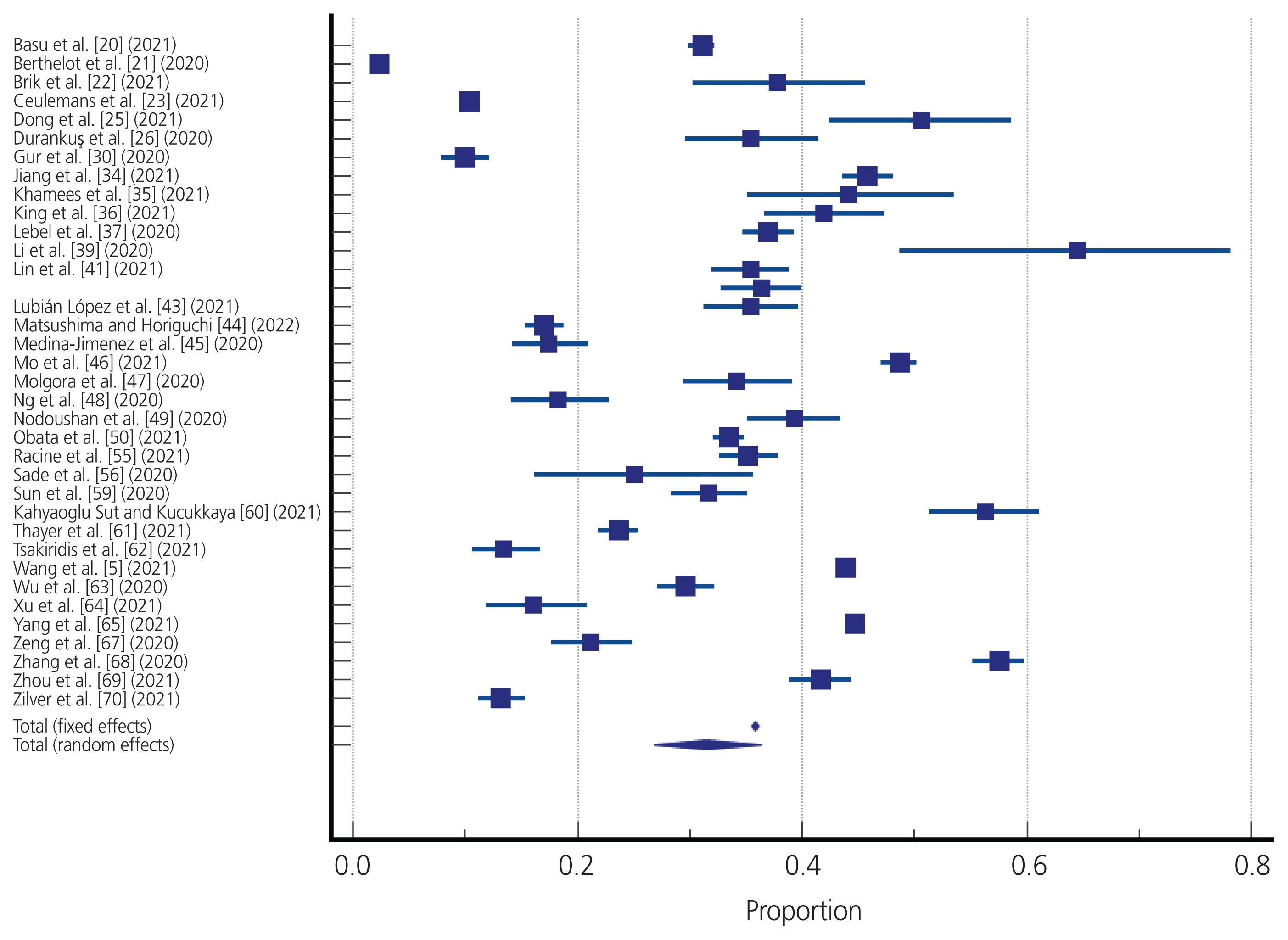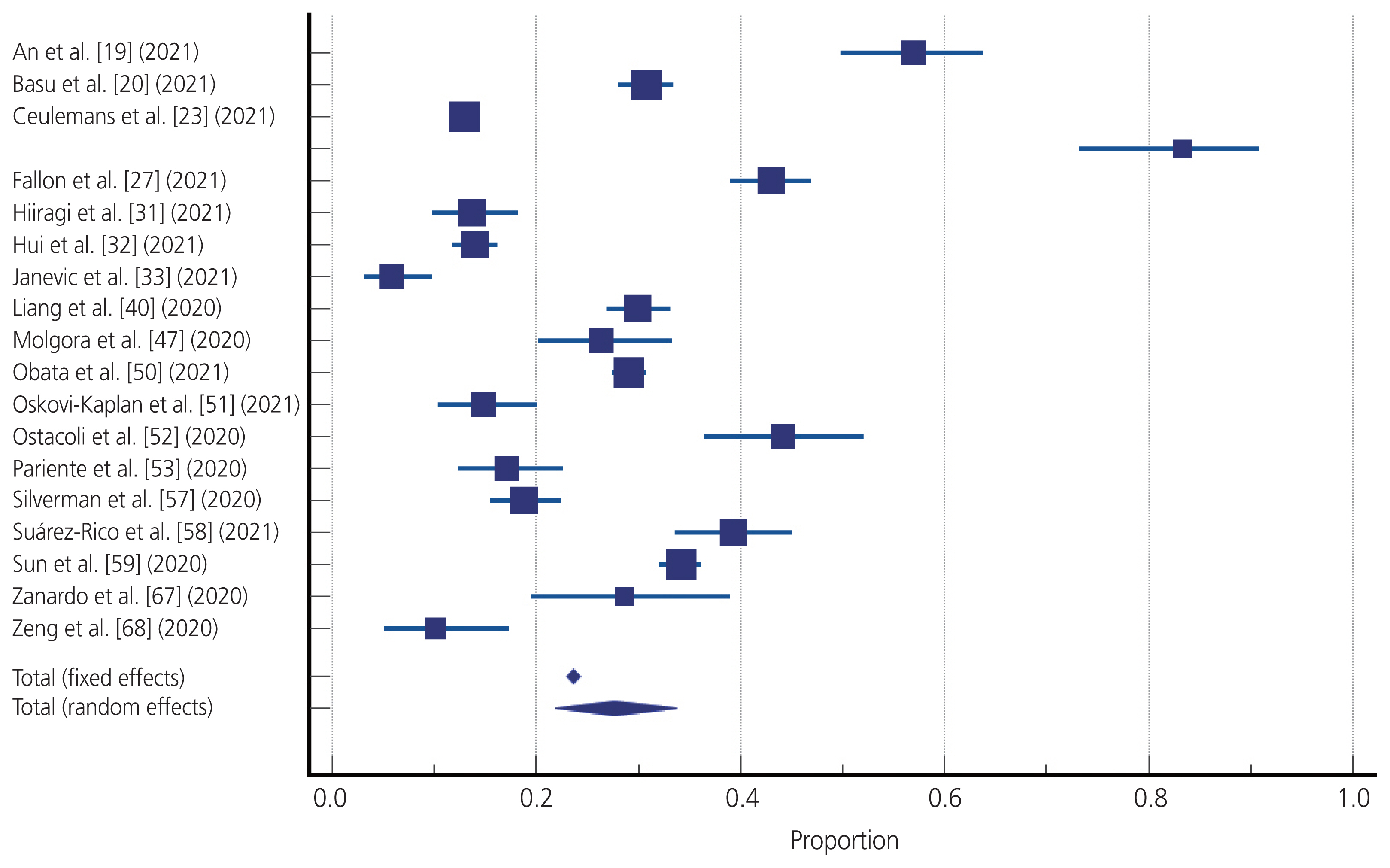Depression in pregnant and postpartum women during COVID-19 pandemic: systematic review and meta-analysis
Article information
Abstract
Coronavirus disease 2019 (COVID-19) emerged as a global pandemic in March 2020 and caused a big crisis, especially the health crisis. Pregnant and postpartum women experienced significant physical, social, and mental changes that put them at higher risk for several conditions during the pandemic. This study aimed to report the prevalence of depression in pregnant and postpartum women during the COVID-19 pandemic. Eligible studies were identified using several databases. Prevalence analysis was conducted using MedCalc ver. 19.5.1. This systematic review and meta-analysis was registered in PROSPERO on July 12, 2021 with registration number CRD42021266976. We included 54 studies with 95.326 participants. The overall prevalence of depression was 32.60% among pregnant and postpartum women during the COVID-19 pandemic. The rate was higher among pregnant women (31.49%) compared to postpartum women (27.64%). The prevalence of depression among pregnant and postpartum women increased during the COVID-19 pandemic.
Introduction
Coronavirus disease 2019 (COVID-19), a novel infectious disease caused by the severe acute respiratory syndrome coronavirus 2 (SARS-CoV-2), was declared a global pandemic by the World Health Organization (WHO) on March 11, 2020 [1]. As of July 4, 2021, over 182 million people had been infected with SARS-CoV-2, causing a global health crisis [2]. The uncertainty caused by the lack of an endpoint for the pandemic, while treatment is still not assurance, significantly impacts individuals’ psychology [3]. Because pregnancy is a period in which subtle changes occur both mentally and physically, pregnant women are considered vulnerable to severe forms of COVID-19 [4]. The COVID-19 pandemic mainly affects pregnant women, as the infection affects both mother and child during and after pregnancy [5]. Pregnant women are prone to developing psychological problems such as mood changes, fatigue, emotional disorders, mixed anxiety-depressive disorders, and pregnancy-related anxiety [6]. Depression and anxiety are the most common psychiatric disorders during pregnancy [7]. Antenatal maternal depression is associated with adverse effects on pregnancy and neonatal outcomes, including spontaneous abortion, bleeding, operative delivery, and preterm birth [8,9].
The incidence of depression during pregnancy and the postpartum period is 20.7% and 17%, respectively [10,11]. According to the WHO, approximately 10% of pregnant women and 13% of postpartum women have mental disorders, the most common of which is depression [12].
Understanding the implications of the COVID-19 pandemic on psychological changes in pregnant and postpartum women is essential to avoid its negative impacts and secondary consequences [13]. To date, there have been various publications on the impact of the COVID-19 pandemic on depressive symptoms in pregnant and postpartum women; however, to the best of our knowledge, this is the most updated meta-analysis regarding depression in pregnant and postpartum women. This review aimed to report the prevalence of depression in pregnant and postpartum women during the COVID-19 pandemic.
Methods
1. Eligibility criteria
The literature search was limited to retrospective and prospective studies published in English or Indonesian. Eligible studies had to meet all of the following inclusion criteria: 1) participants were pregnant or delivery women; 2) participants met the clinical cut-off point for depression, assessed through validated questionnaire/healthcare professional diagnosis; 3) data were obtained during the COVID-19 pandemic; 4) empirical or original research studies; and 5) studies that reported the prevalence rates of depression among pregnant and postpartum women during the COVID-19 pandemic.
Single case reports, editorials, commentaries, letters, nonfull-texts, and unpublished or non-peer-reviewed articles were excluded from our review. Single case reports were excluded because they tend to report only severe or unique cases and have the lowest evidence quality. Studies that reported only patients with severe features were also excluded from this review.
2. Information sources
A systematic search of studies was conducted electronically on several databases, including PubMed, EBSCO, and ProQuest, until June 30, 2021. MeSH terms, keywords, and word variants for “COVID-19,” “SARS-CoV-2,” and “pregnancy” were used. References of relevant articles or reviews were searched for additional studies.
3. Search strategy
To perform a systematic review and meta-analysis of studies evaluating depression in pregnant and postpartum women, we used the retrieval expressions: “pregnant women or pregnancy or perinatal or postpartum;” “SARS-CoV-2 or COVID-19 or coronavirus;” and “stress or psychological or mental or depression or depressive or psychology.”
4. Selection process
The articles used in this systematic review and meta-analysis were assessed independently by two authors (NA and JC) for study quality using the Newcastle-Ottawa Scale et al. [14]. This study was reported according to the Preferred Reporting Items for Systematic Reviews and Meta-Analysis (PRISMA) statement and Meta-Analysis of Observational Studies in Epidemiology (MOOSE) guidelines [15,16]. All abstracts were reviewed by two authors independently. Any disagreement regarding the relevance of a study was resolved through discussion with a third author (FBP). In cases of studies with the same cohort and identical endpoints, the study with the most comprehensive information was used, while the others were excluded to avoid overlapping cases.
5. Statistical analysis
Meta-analysis of proportions was used to combine all the data; logit transformations were conducted before meta-analysis, and the reported pooled proportions of depression were calculated using a random-effects model. All meta-analyses were performed using MedCalc, version 19.5.1 (MedCalc Software Ltd, Ostend, Belgium). [17]. The P-value for the overall effect, P<0.05 with two-tailed, was considered statistically significant. I2 was used to assess the heterogeneity of all the detailed studies. When it was lower than 50%, studies with acceptable heterogeneity were considered, and the fixed-effects model with the Mantel-Haenszel method was used; otherwise, a random-effects model with the DerSimonian and Laird method was adopted.
Publication bias was assessed for each pooled study group using Egger’s linear regression test. As a supplementary approach, Begg’s rank correlation was also applied to assess potential publication bias; when P was >0.05, there was no publication bias in the study.
Results
1. Search results
The initial articles identified from the electronic database yielded 1,112 studies. After screening the titles and abstracts, 73 articles were identified. Finally, 54 studies were included in this meta-analysis. The search flowchart and selection methods used in this study are summarized in Fig. 1.
2. Characteristics of the included studies
Fifty-four studies were included in this systematic review and meta-analysis (Table 1) [18–70]. The included studies were conducted between January 1, 2020 and June 30, 2021 with 95.326 participants. Among the 54 studies, 42 were cross-sectional, 10 were cohort, one was case-control, and one was mixed. Approximately 32 studies were conducted with Edinburgh Postnatal Depression Scale (EPDS), eight with Patient Health Questionnaire-9 (PHQ-9), three with Patient Health Questionnaire-2 (PHQ-2), two with Hospital Anxiety and Depression Scale (HADS), two with Edinburgh Depression Scale (EDS), two with Depression Anxiety and Stress Scale (DASS), one with Patient Health Questionnaire-4 (PHQ-4), one study with Kessler Psychological Distress Scale (K-10), one with Self-Depression Scale (SDS), one with the 10 item Center for Epidemiologic Studies Depression Scale (CES-D-10), and one with professional health diagnosis. The mean maternal age and gestational age in this research was 30.26 years and 25.73 weeks, respectively. This review included studies from many countries. However, most studies were conducted in a single country, with only a few conducted multinationally. These countries include China, Hong Kong, Japan, Iran, Qatar, Israel, Egypt, Turkey, Italy, Switzerland, the Netherlands, Greece, Spain, the United Kingdom, Ireland, Norway, Poland, the United States of America, Canada, and Mexico. All studies were assessed for quality using the New-castle-Ottawa Scale (Tables 2, 3).
3. Prevalence of depression among pregnant and postpartum women during the COVID-19 pandemic
A random-effects meta-analysis of 54 studies revealed a pooled event rate of 0.326 (95% confidence interval [CI], 0.284–0.369), which suggested that the prevalence of depression was 32.6% across the study. This meta-analysis found no evidence of publication bias, which was confirmed statistically by the Begg’s test and Egger’s test of intercept. There was significant between-study heterogeneity (Q=9778.38, P<0.001, I2=99.46). For the pregnant and post-partum women subgroups, a random-effects meta-analysis of 36 and 19 studies revealed pooled event rates of 0.314 (95% CI, 0.268–0.363) and 0.276 (95% CI, 0.219–0.337), respectively. Both results suggested that the prevalence of depression across the studies were 31.4% and 27.6% for pregnant and postpartum women, respectively. Significant heterogeneity between-studies was also demonstrated in both the pregnant and postpartum women subgroups (Q=6728.83, P<0.001, I2=99.48 and Q=1132.91, P<0.001, I2=98.41). The forest plots of the data are shown in Figs. 2–4.
Discussion
In this meta-analysis, we found significantly elevated rates of depression among pregnant and postpartum women during the COVID-19 pandemic compared with the global prevalence of depression before the COVID-19 pandemic, which ranged from 17–20.7% [10,11]. Approximately one-third of the pregnant and postpartum women in this study developed depression during the COVID-19 pandemic. Pregnant and postpartum women undergo significant physical, social, and psychological changes. Consequently, they may be at higher risk of developing mental health problems, particularly depression. Several studies have revealed that depression was prevalent among pregnant women and those in the post-partum period before the COVID-19 pandemic [13,71–78]. In addition, the present study showed a higher prevalence of depression in pregnant and postpartum women during the COVID-19 pandemic than in the general population, which was 28.0% [79].
Since its recognition in December 2019, COVID-19 has spread rapidly worldwide, with serious health, social, and financial consequences. The COVID-19 pandemic has caused significant public health emergencies and resulted in increased fear, anxiety, and uncertainty, especially among pregnant women who are more susceptible to respiratory pathogens and are at an increased risk of severe pneumonia due to the immunological and physiological changes that occur during pregnancy [80]. The prevalence of depression in pregnant and postpartum women increased during the COVID-19 pandemic, ranging from 17% to 31% [13,80–85]. A systematic review and meta-analysis of 19 studies revealed that the pooled prevalence of depression in pregnant and postpartum women during the COVID-19 pandemic was 25% [82]. Another meta-analysis of 15 studies with 11.187 pregnant women found the prevalence of depression to be 30% [85]. A study conducted by Yan et al. [86] (that included 23 studies with 20.569 participants) also found that the prevalence of depression in pregnant and postpartum women was high during the COVID-19 pandemic. Fears of contracting or transmitting COVID-19, worry about their pregnancy and the health of their newborn, the lockdowns/ quarantine, poor economic conditions, loss of income, insufficient social support, and lack of access to healthcare professionals contributed significantly to the mental health of pregnant and postpartum women during the COVID-19 pandemic [28,29,35,40].
During the COVID-19 pandemic, meeting the mental health needs of pregnant and postpartum women was a considerable challenge. Prenatal and postnatal psychiatric problems have substantial long-term adverse effects on mothers, fetuses, and children. The negative consequences include complications during pregnancy and childbirth (pre-eclampsia, miscarriage, preterm birth, gestational hypertension, low infant birth weight, and stillbirth) [87,88]. A systematic review and meta-analysis conducted by Chmielewska et al. [89] revealed that the incidence of maternal mortality, maternal stress, stillbirth, and ruptured ectopic pregnancy was higher during the COVID-19 pandemic compared to that before the COVID-19 pandemic.
Several factors increased the risk of depression in pregnant women during the COVID-19 pandemic, including COVID-19-related worries (fear of infection, worry about the baby’s safety during pregnancy, and the health of family members) [80]. Social restrictions arising from the pandemic constrained pregnant women from accessing healthcare services. Moreover, pregnant women may have been concerned about the possibility of exposure to SARS-CoV-2 when visiting medical facilities, which compelled them to delay antenatal care visits, obstetric examinations, and hospitalization before delivery. In addition, they also wanted to give birth by cesarean section rather than wait for delivery in the hospital [90]. Depression during pregnancy, if left untreated, can have negative obstetric consequences and is linked to inadequate prenatal care, poor maternal health, and postpartum depression [91].
Similar to other mental disorders, biopsychosocial factors are implicated in the etiology of postpartum depression. The possibility of getting infected by SARS-CoV-2 became a new stressor for postpartum women during the pandemic. The uncertainty and unpredictability of the pandemic, which caused fluctuations in regulations, could have played a role [40]. Some situations related to the pandemic such as decreased socioeconomic status and the absence of visitors were risk factors. Lack of support from healthcare staff due to the hospitals’ rush during the pandemic was also a risk factor. Postpartum women living in high-risk COVID-19 transmission areas have a higher risk of developing postpartum depression [52]. We cannot ignore the role factors such as mother’s personal history, poor marital relationship, and prior negative pregnancy experience play in the development of depression, in addition to pandemic-related risk factors [52].
We included all available high-quality studies and updated the literature on depression among pregnant and postpartum women. Our study also highlighted the vulnerable groups among the study population.
This study has some limitations. First, there was high heterogeneity between the included studies; however, the funnel plot was symmetrical. The primary cause of heterogeneity is thought to be the various scales and cut-offs used for its analysis (EPDS, PHQ-9, PHQ-2, HADS, EDS, DASS, PHQ-4, K-10, SDS, and CES-D-10), with only one study conducted by professional health diagnosis. Samples were collected at different times and in different countries in each study. Hence, the challenge faced during the COVID-19 pandemic that served as a stressor differed in every study. Furthermore, the use of self-reported questionnaires may indicate the presence of biases such as social desirability bias, such that pregnant women may have underreported or overreported their data. Second, most of the included studies collected data through online surveys, resulting in a selection bias [92,93]. Finally, majority of included studies were cross-sectional. Hence, further studies on the long-term impact of the COVID-19 pandemic on the mental health of pregnant and postpartum women, particularly depression, are needed.
Conclusion
In conclusion, we demonstrated that the prevalence of depression among pregnant and postpartum women during the COVID-19 pandemic was higher than that before the COVID-19 pandemic. The rate of depression is higher in pregnant women than in postpartum women.
Notes
Conflict of interest
There is no conflict of interest in this research.
Ethical approval
No ethical approval was required because this review analyzed published data.
Patient consent
No patient consent was needed for this research.
Funding information
None.


